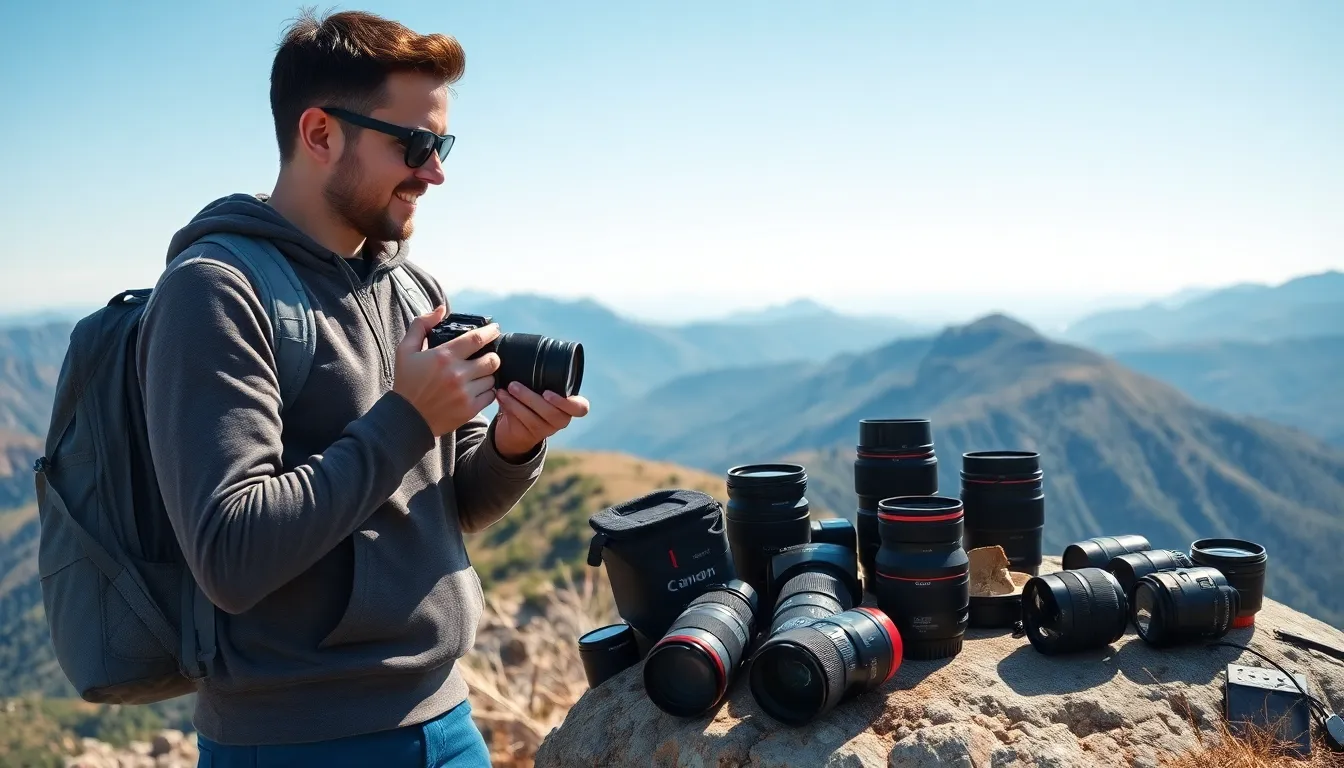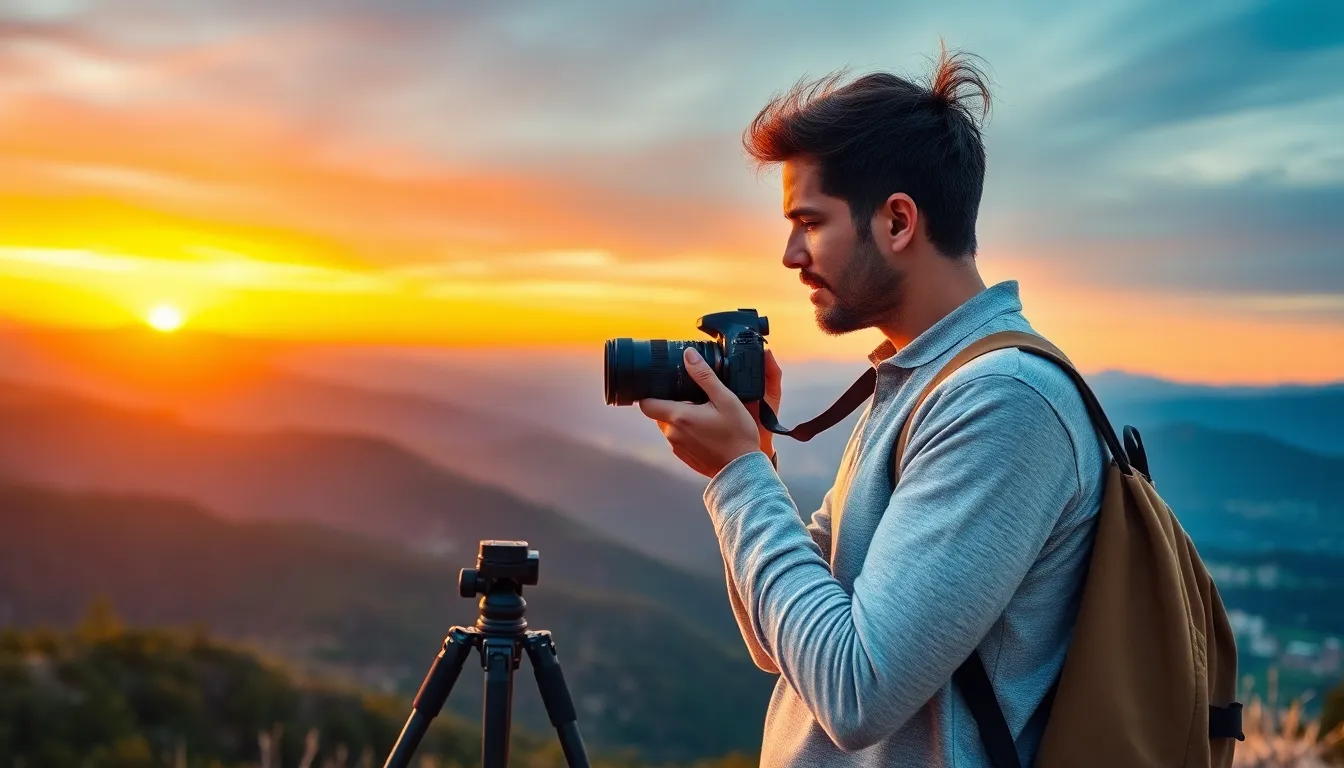Table of Contents
ToggleTraveling is an adventure, but capturing those epic moments can feel like a challenge. Whether it’s that stunning sunset over the Grand Canyon or the quirky street art in a bustling city, knowing how to snap the perfect shot can turn a good trip into a legendary one. With a few savvy travel photography tips, anyone can elevate their game from amateur to pro, all while avoiding the dreaded “blurry tourist” look.
Essential Travel Photography Tips
Utilize natural light for photography. Early mornings and late afternoons provide soft light that enhances colors and details. Carry a tripod for stability in low-light conditions to avoid blurred images. Focus on the composition by applying the rule of thirds; position key elements along the lines or at intersections for balance.
Explore different perspectives. Get low to the ground or find higher vantage points for unique shots. Include foreground elements to create depth in images. Experiment with various angles to add interest and intrigue.
Consider the subject carefully. Capturing local culture adds storytelling elements to photos. Bring out candid moments by photographing people engaged in daily activities. Encourage interaction with subjects when possible to make images more vibrant.
Set a specific theme for each location. Document the essence of a city or landscape by selecting a distinctive aspect to highlight. Organize a photo walk to focus solely on capturing images without distractions.
Adjust camera settings based on conditions. Use a higher ISO setting for fast-moving subjects or low-light situations while utilizing a lower setting for bright environments. Shoot in RAW format to retain image quality and flexibility during editing.
Edit photos thoughtfully. Utilize software like Adobe Lightroom or Snapseed for adjustments in brightness, contrast, and color. Maintain natural appearances to ensure authenticity while enhancing visual appeal.
Stay prepared for spontaneous moments. Always carry a camera, even on casual outings. Remain alert to unexpected scenes and opportunities to photograph unique experiences. Embrace creativity by turning ordinary moments into extraordinary images.
Equipment Recommendations

Selecting the right equipment significantly enhances travel photography. Key items include cameras and lenses that cater to the needs of photographers on the go.
Cameras for Travelers
DSLRs and mirrorless cameras offer versatile options for travel photography. The Canon EOS R series provides excellent image quality paired with portability. Nikon Z series cameras also deliver impressive results in various lighting conditions. Compact point-and-shoots, like the Sony RX100 series, allow for easy carrying without sacrificing quality. Additionally, smartphone cameras now feature advanced settings and multiple lenses, making them suitable for spontaneous captures. Battery life and storage capacity remain crucial for extended trips.
Lenses to Consider
Wide-angle lenses are essential for landscape shots and capturing expansive scenes. A 16-35mm lens works well for immersive perspectives. A standard zoom lens, such as 24-70mm, provides versatility for different scenarios, from portraits to scenic views. For wildlife, a telephoto lens like 70-200mm offers the ability to capture distant subjects clearly. If photographing in low light, a fast prime lens with a wide aperture can enhance image quality. Lightweight options simplify transportation during travels. Prioritize versatility to adapt to different environments and subjects encountered during trips.
Techniques for Stunning Shots
Capturing breathtaking travel images requires specific techniques that enhance overall shot quality. Paying attention to composition and light can transform a photograph from ordinary to extraordinary.
Composition Basics
Start by applying the rule of thirds, which involves dividing the frame into a grid of nine equal sections. Placing key elements along these lines or their intersections creates balance and draws the viewer’s eye. Experimenting with different angles adds depth; shooting from a low or high point can give subjects a unique perspective. Centering the subject works too but can produce symmetry, ideal for architecture or landscapes. Incorporating leading lines guides the viewer’s gaze to the focal point, directing attention effectively. Lastly, don’t forget about negative space, which emphasizes the main subject and brings focus.
Utilizing Natural Light
Utilizing the soft glow of natural light enhances image quality significantly. Early mornings and late afternoons, known as the golden hours, create warm tones and rich colors, ideal for vibrant shots. Overcast days provide diffused light, minimizing harsh shadows that could compromise detail. Positioning the subject to face the light often results in a lively image, while backlighting can create dramatic silhouettes. Using light to highlight textures adds depth and dimension. Shifting camera angles frequently allows photographers to discover the light’s best impact, leading to stunning, dynamic photographs.
Capturing Local Culture
Capturing local culture enriches travel photography. Engaging with locals creates authentic experiences and visuals.
Engaging with Locals
Interaction with residents often leads to stunning portraits that tell stories. Approach people with genuine curiosity and respect for their space. Photographers should ask for permission before taking close-up shots. Capturing candid moments during conversations or community activities showcases the essence of local life. Sharing a brief story or asking about their traditions fosters trust. These connections often result in richer photographs that reveal the character of the destination.
Photographing Traditions and Events
Documenting local traditions and festivals offers unique photographic opportunities. Attend events like markets, religious ceremonies, and cultural performances to capture vibrant imagery. Photographers should focus on the details, such as costumes, food, and rituals, to convey the atmosphere. Timing is crucial; arriving early allows for exploration of the environment, while staying late captures the energy as events unfold. Engaging with the event ensures that photographs reflect the spirit of the occasion. Patience often leads to surprise moments that encapsulate the beauty of the culture.
Post-Processing Tips
Post-processing enhances travel photos, transforming them into impressive visuals. Utilizing the right tools and techniques makes a substantial difference in the final outcome.
Editing Software Suggestions
Consider using software like Adobe Lightroom for powerful editing capabilities. Capture One excels in color grading and offers advanced features. For quick adjustments, Snapseed provides user-friendly options on mobile devices. Affinity Photo serves as a cost-effective alternative with robust tools. Choose software based on individual needs, keeping functionality and ease of use in mind.
Enhancing Your Photos
Adjust exposure to brighten underexposed images, ensuring details pop. Increase contrast to add depth, making images more dynamic. Utilize sharpening tools to enhance texture and clarity, especially in landscapes. Crop images effectively, aligning them with the rule of thirds for visual appeal. Apply color correction to maintain authenticity while improving vibrancy. Experiment with filters sparingly, preserving the original feel of the scene. Each technique contributes significantly to elevating the quality of travel photographs.
Travel photography is an art that transforms experiences into lasting memories. By implementing the tips shared in this article, photographers can elevate their skills and capture stunning images that truly reflect their journeys. Embracing natural light and exploring various perspectives can add depth and interest to each shot.
Moreover, engaging with local cultures not only enriches the travel experience but also leads to authentic and compelling photographs. With the right equipment and thoughtful editing techniques, anyone can create impressive visuals that tell a story.
Ultimately, the key to great travel photography lies in preparation, creativity, and a willingness to embrace spontaneity. Each trip offers a unique opportunity to capture moments that resonate long after the journey ends.




